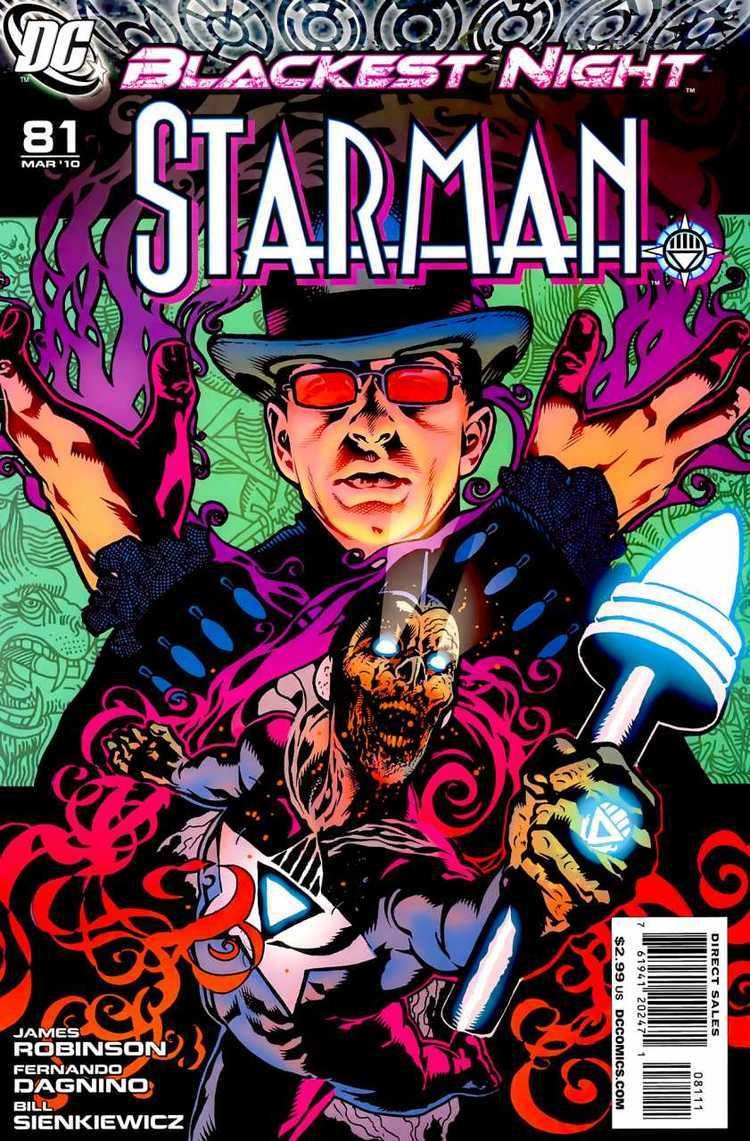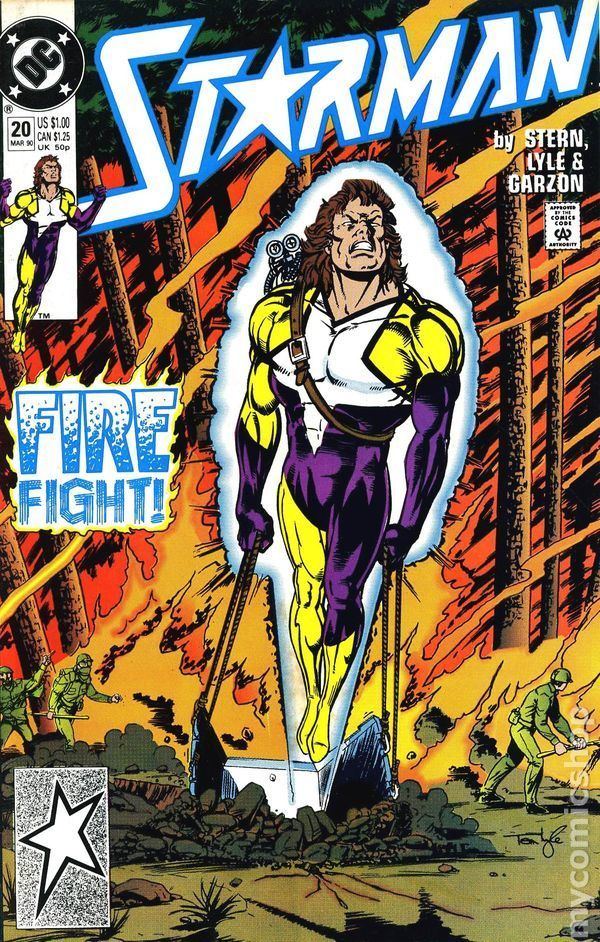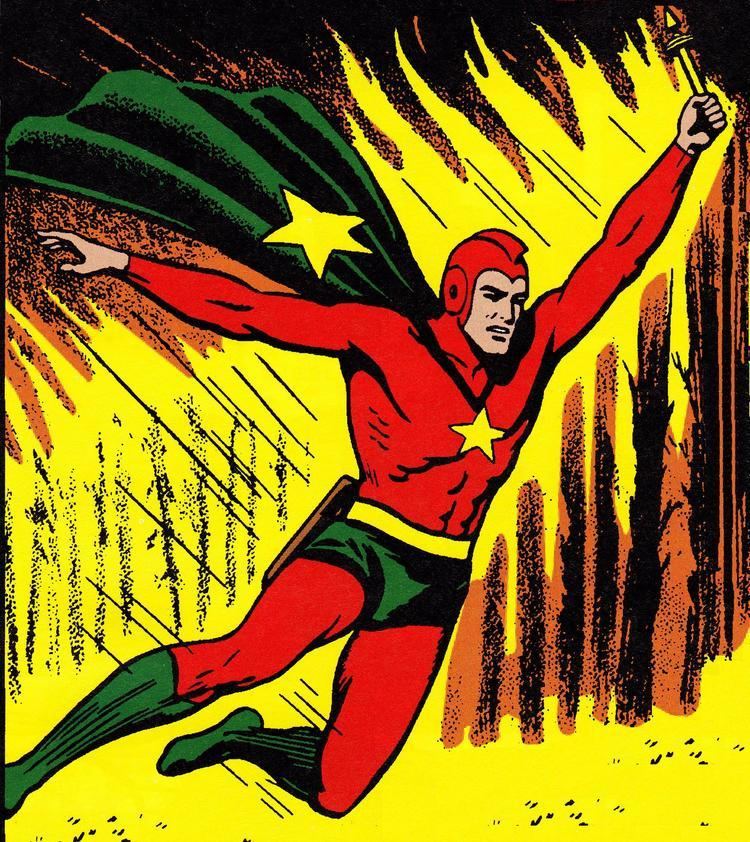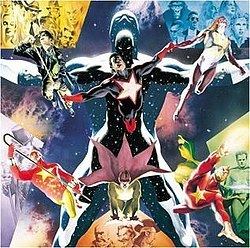Genre Superhero Number of issues 45 | Publisher DC Comics Fictional universe DC Universe | |
 | ||
Created by (Star-Man)
Sheldon Moldoff
(Tomas)
Gerry Conway, Mike Vosburg
(Gavyn)
Paul Levitz, Steve Ditko
(Payton)
Roger Stern, Tom Lyle
(David)
Roger Stern
(Jack)
James Robinson, Tony Harris
(Farris)
Grant Morrison
(Old West/Sono)
Jimmy Palmiotti, Justin Gray Alter ego Victor Sono
Theodore Knight
Bruce Wayne (pre-Crisis)
Mikaal Tomas
Prince Gavyn
Will Payton
David Knight
Jack Knight
Farris Knight
Charles McNider
Thom Kallor Place of origin (Tomas)
Talok III
(Gavyn)
Throneworld Abilities (Star-Man)
Super-Strength
(Tomas)
Flight and energy projection derived from the sonic crystal
Invulnerabilty
(Gavyn)
Flight, energy projection & absorption, light/heat and radiation immunity
self-sustenance
able to withstand exposure to space
(Payton)
Flight, superstrength, superhuman durability, limited shapeshifting, energy projection
(David)
Use of the "Gravity Rod"
(Farris)
Use of the "Quarvat" First appearance (Ted), Adventure Comics #61 (April 1941) Creators Grant Morrison, James Robinson, Roger Stern, Tom Lyle Similar Batman/Hellboy/Starman, Doctor Fate, Spectre, Adventure Comics, Manhunter | ||
Starman is a name used by several different DC Comics superheroes, most prominently Ted Knight and his sons David and Jack.
Contents
- Theodore Knight
- Starman of 1951
- Star Man
- Mikaal Tomas
- Prince Gavyn
- Will Payton
- David Knight
- Jack Knight
- Thom KallorDanny Blaine
- One Year Later
- Farris Knight
- Victor Sono
- Other versions
- Starman vol 1
- Starman vol 2
- Style
- Reception
- Awards and nominations
- Collected editions
- In other media
- References

Created by writer Gardner Fox and artist Jack Burnley, the original Starman, Ted Knight, first appeared in Adventure Comics #61 (April 1941). An astronomer, Knight invented a "gravity rod", later reinvented as a "cosmic rod", allowing him to fly and manipulate energy, and donned a red and green costume with a distinctive finned helmet.

Like most Golden Age heroes, Starman fell into obscurity in the 1950s. In the ensuing years, several characters, with varying degrees of relation to the original, briefly took the mantle of Starman.

In Zero Hour: Crisis in Time #1 (September 1994), writer James Robinson and artist Tony Harris introduced Jack Knight, the son of the first Starman. A reluctant, non-costumed hero, he inherited his father’s name and mission and used his technology to create a cosmic staff. He starred in a critically acclaimed series, written by Robinson, from 1994 until 2001.

The current successor of Starman is Stargirl, formerly the second Star-Spangled Kid.
Below, in chronological order of activity (not of appearance), are the characters to have used the name "Starman".
Theodore Knight

Theodore Henry Knight is a 1940s DC Comics superhero who wore a red costume with a finned helmet and a green cape, and wielded a "gravity rod" (later "cosmic rod") which enabled him to fly and fire energy bolts as a member of the Justice Society of America.
Starman of 1951

The Starman of 1951 is a superhero who operated in the DC Universe in 1951. In actuality, he is a retcon who appeared in Starman (vol. 2) and whose identity was revealed towards the end of that series as being the original Dr. Mid-Nite, Charles McNider, and later a time-displaced David Knight, son of the original Starman, Ted Knight, after some training from McNider. This proved to be only a temporary reprieve for the deceased hero however.
In pre-Crisis continuity, the only Starman of the 1950s was actually Batman who briefly took up that mantle in Detective Comics #247 (September 1957), using variants of his usual equipment, but with a star motif instead of a bat, due to him having been hypnotized to be given a fear of bats in the belief that this would render him incapable of being a hero.
Star-Man
In Detective Comics #286 a villainous Star-Man appeared to menace Batman and Robin whose super-strength waned in the presence of a Tibetan belt worn by Batwoman.
Mikaal Tomas
Mikaal Tomas (also known as Michael Thomas) is a DC Comics superhero, introduced in the 1970s. Tomas is an alien who traveled to Earth to help conquer it, but instead turned against his war-like people in defense of the human race. He has blue skin and originally wore Mister Miracle-style flight-discs on his feet that allowed him to fly, and a medallion containing a sonic crystal around his neck. The gem eventually became embedded in his chest and allows him to fire bolts of energy. He first appeared in 1st Issue Special #12 (March 1976). Within the story, Mikaal was given the name Starman not as a means of carrying on Ted Knight's legacy, but rather in reference to the song "Starman" by David Bowie. The song tells of a benevolent alien who arrives on Earth in order to save the planet from destruction, a situation which greatly parallels Mikaal's backstory. The character later suffered amnesia until he turned up in the 1990s Starman series. The 1990s series revealed that Mikaal's homeworld was Talok III, sister planet to Talok VIII, the home of Shadow Lass. The inhabitants of the eighth planet have darker blue skin, but they are the same species. Tomas' origins have been noted to bear certain similarities to that of Captain Mar-Vell of Marvel Comics.
In James Robinson's 1990s series, Starman became notable for being portrayed in a gay relationship; Mikaal's partner Tony was introduced in a 1998 issue of Starman. Starman's specific sexual identity was not addressed in print. His long-term relationship with Tony lasted, in DC continuity, twelve years, interrupted by Tony's death. A 2010 Robinson story subsequently clarified that Mikaal identifies himself as gay.
In 2009, writer James Robinson returned to the character, reintroducing him as a main character in Justice League: Cry for Justice. In the first issue, Tony, his lover from the Starman series, is killed while visiting his parents in New York by unnamed supervillains, prompting Mikaal to seek justice. He meets and befriends Congorilla, a fellow hero who is also mourning the loss of someone close to him, in this case his partner and close friend, Freedom Beast. The two heroes travel to Paris, where they find the two assassins who murdered their loved ones, and in the ensuing fight both villains are killed before they can reveal who hired them. After asking Animal Man for help, the heroes travel to the Justice League Watchtower, only to soon find themselves in the midst of a battle with Prometheus, the villain that hired the assassins to kill Tony and Freedom Beast. Mikaal and his companions are easily defeated, and Prometheus escapes after destroying Star City. Mikaal is later shown helping Congorilla and the members of the Justice League search for survivors in the ruins of the city.
After this, Mikaal appears in the main Justice League of America series, where he tries to help Congorilla after he is attacked by a group of villains working for Doctor Impossible. Robinson officially added Mikaal to the Justice League. In his first mission with the team, he helped capture Plastique and her companions after they tried to flee the country. During Brightest Day, Mikaal is sent into space by Batman (Dick Grayson) in order to find Alan Scott after he goes insane and vows to destroy the world. Mikaal tracks Alan to the moon, where he has constructed a massive fortress composed of green energy. Before Mikaal can relay this information to his teammates, Scott attacks him and violently tears the gem from his chest. Miss Martian is able to mentally contact Mikaal, who claims that he has been imprisoned in Alan's fortress and fears that he may be dying. He is ultimately rescued by Doctor Mid-Nite and joins his teammates in defeating Alan.
Mikaal soon spirals into a delayed depression over Tony's death. He is confronted by Congorilla, who wishes him to help find Malavar, a Gorilla scientist specialising in transdimension research, in order to help heroes break into the energy dome that has been erected around Washington, D.C. during the Omega storyline. After some heart-to-heart about Mikaal moving on, they discover Malavar was seeking the Fountain of Youth, and so gain the aid of Rex the Wonder Dog, a sapient dog who is aware of the Fountain's location, and Animal Man, who translates what Rex says. The group head off to its location in the Florida Everglades, and save Malavar who reveals he's there attempting to resurrect the 'one who kept him sane' during his captivity by Prometheus. They fight off Gorilla City terrorists keen to kill the renowned ape, during which Malavar's saviour, Tasmanian Devil, revives and joins the fight, helping the group win. After the battle is done, the weary Tasmanian Devil is sent home to rest, and the remaining group head off to assist efforts in Washington, D.C.. Congorilla notes to Mikaal that Tasmanian Devil is also gay, and would make a suitable partner - Mikaal expresses belief that perhaps it is best to move on (but not forget his time with Tony), and expresses interest in Congorilla's suggestion; the two heroes are dating.
Later, during a battle between the Justice League and Doomsday, it was discovered that Mikaal's gem somehow affected Saint Walker's blue power ring. Starman played a pivotal role in the League's final adventure, where he and the Atom were shrunken down and sent inside the Shade's brain. The two heroes freed Shade from Eclipso's control, allowing the JLA to defeat Eclipso once and for all. Following an injury sustained during a battle on Gemworld, Starman resigned from the League. The team officially disbanded shortly after this. Following the events of Flashpoint, Mikaal is indeed shown back in Opal City, now operating as a solo hero once again. Despite having left the League, a conversation with the Shade implies that Mikaal is indeed still friends with Congorilla.
Prince Gavyn
Prince Gavyn, a 1980s DC Comics superhero created by Paul Levitz and Steve Ditko, was the spoiled blond playboy prince of an alien empire. He discovered he was a mutant who could survive unaided in space when, by ancient royal custom, he was thrown out of a spaceship airlock to prevent him from challenging his more mature sister's claim to the leadership of the imperial planet Throneworld. Gavyn was given jeweled wristbands and a staff by the mysterious mystic M'ntorr, which allowed him to channel his cosmic powers into the ability to fly interstellar distances and shoot bolts of energy. For a time keeping his true identity a secret as a masked protector of the realm, after the assassination of his sister only one year into her reign, he became ruler of their people. He first appeared in Adventure Comics #467 (January 1980) and was believed to have died in the Crisis on Infinite Earths. His story was elaborated upon in Starman Annual #1, the tie-in to the comics event Legends of the Dead Earth.
The 1990s Starman series revealed that his fate was different from previously believed. It was revealed that Gavyn was converted into pure energy, which became the source of the beam of light that struck Will Payton, a later Starman, granting him his powers. It is then revealed by Gavyn's tutor that Will Payton died when struck by the energy and his essence was infused in Will Payton's body.
Gavyn reappeared during the Rann-Thanagar War, defending Throneworld from Thanagarians alongside the Omega Men, and later its sequel Rann-Thanagar Holy War.
During the events of the Strange Adventures mini-series that followed Rann-Thanagar Holy War, Gavyn was transformed by Synnar the Demiurge into a flame-haired being called Fusion.
Will Payton
Will Payton, a 1980s DC Comics superhero, was created by Roger Stern and Tom Lyle. Payton gained his powers of flight, super strength, a mild amount of shapeshifting, and the ability to alter his appearance and fire bolts of energy from his hands after being struck by a bolt of energy from a satellite in space. He was in his early twenties and worked as a magazine copy editor. The satellite had been launched by the Hutchison Institute, and the powers had been intended for their team of super-agents the Power Elite. Despite his short career, he gained a good reputation among other heroes, even assisting Superman on some occasions, such as helping him recharge after an encounter with Parasite drained most of his solar energy, and posing as Superman when he was briefly depowered by Lex Luthor's use of Mister Mxyzptlk's Red Kryptonite (although he was forced to leave to recover after he was injured in a confrontation with evil genius Thaddeus Killgrave). He first appeared in Starman (vol. 1) #1 (October 1988) and seemingly died fighting the supervillain Eclipso.
The 1990s Starman series revealed that his fate was different from that previously believed. The mysterious bolt of energy that infused Payton with his cosmic abilities was revealed to be the essence of the alien Prince named Gavyn, who also used the name Starman. It is currently unclear whether the two men, Gavyn and Payton, fused into one being with shared memories, or if Payton was killed by the bolt that struck him and was replaced by the essence of Gavyn.
David Knight
David Knight, a 1990s DC Comics superhero, was the son of the original Starman and elder brother of the 1990s Starman, Jack. He first appeared in Starman (vol. 1) #26 (September 1990), having taken up his father's mantle, and was killed by an assassin in Starman (vol. 2) #0 (October 1994). He regularly (annually) appeared to Jack after his death, providing guidance for his brother. Toward the end of the series, his ultimate fate was revealed to have been different from what was previously believed (as noted above for the Starman of 1951).
In Starman (vol. 2) #81 (a one-issue revival tying into the Blackest Night event), David's corpse is reanimated as a member of the Black Lantern Corps. He unsuccessfully targets Hope and Mason O'Dare, and then confronts Shade, who pulls him into the Shadowlands, imprisoning him there. During their confrontation, the Black Lantern mentions his plan to lure Jack into another "talking with David" scene before killing him, a reference to David's prior role in the series.
Jack Knight
Jack Knight, a 1990s DC Comics superhero, is the son of the original Starman, Ted Knight. He wields a cosmically-powered staff, but refuses to wear a costume, instead preferring a T-shirt, leather jacket (with star emblem on the back), a Cracker Jack prize sheriff's star, and light-shielding tank goggles. A reluctant hero that took up the mantle after David died, he is the protagonist of the comic book series written by James Robinson. Jack briefly joined the JSA, but soon retired at the end of the Starman series, passing along his cosmic rod to the JSA's young heroine, Stargirl.
Thom Kallor/Danny Blaine
Danny Blaine is a DC Comics superhero of the near future whose identity (but not his full story) is revealed in the 1990s Starman series. Danny Blaine was eventually revealed to be Thom Kallor, also known as Star Boy, a DC Comics superhero in the 30th century and a member of the Legion of Super-Heroes. He originally had powers similar to Superboy, but later lost them and retained only his innate ability to increase the mass of nearby objects. Thom takes on the mantle of Starman in the 21st century with the full knowledge that he will lose his life there. The Danny Blaine/Thom Kallor version was inspired by the Kingdom Come depiction of the character, designed by Alex Ross.
One Year Later
The One Year Later line-up of the Justice Society had a new, schizophrenic Starman. Fully aware of his condition and plagued by voices and shattered impressions of his adventures through time and space, he voluntarily went to reside at the Sunshine Sanitarium in Opal City when not performing his super-heroic feats, seeking a cure and protection until the JSA sent Doctor Mid-Nite and Stargirl to recruit him. He accepted, asking only a cure for his addled mind in exchange.
Hailing from the original Legion of Super-Heroes universe, where he was known as Star Boy, he received from Brainiac 5 of the Three Worlds a complete map of the Multiverse, printed on his star-clad suit, to use in a mission meant to save the entire space-time continuum. It was implied that his addled status was actually a deciding factor in his choice, since his borderline insanity was meant to prevent telepaths or skilled interrogators from gaining any information from him. However, he got stranded on Earth-22, the Kingdom Come universe, thus witnessing the dramatic events on that Earth and receiving added damage to his frail mind, worsened by the lack of the advanced medication to which he had had access in his own time.
He later decided to take the name of Danny Blaine, after his favorite pulp adventurer from Xanthu, a situation that paid off when his mental sanity was restored to him by the literal-minded Old God Gog. Unable to ensure the absolute secrecy of his mission while being Starman all the time, he accepted a job as a gravedigger in Metropolis. With Gog's defeat, Starman was returned to his disturbed state, steadily worsening due to his lack of proper medication; however, in his work as a gravedigger, he was able to locate Superboy/ Kon-El's corpse and transport it to the Fortress of Solitude; where it lay under special Kryptonian crystals in a regeneration chamber for 1000 years. The crystals recharged Conner's (Superboy) life force; thus bringing on his resurrection 1000 years in the future as seen in "Final Crisis: The Legion of 3 Worlds" – The penultimate chapter of "The Lightning Saga".
Farris Knight
The Starman of the 853rd century is Farris Knight, who is also a member of Justice Legion Alpha and was a major character in the series DC One Million. He is a distant descendant of Jack Knight's and the Mist's son. Farris commands an alien artifact called a "quarvat", similar in function to the "cosmic rod". He lives on a space station (in the orbit of Uranus) from which he monitors the artificial sun Solaris. He asserts that being the descendant of the Mist as much as the Knights, he was predisposed to villainy, and Solaris eventually corrupts Farris. The man arranges for the defeat of the two JLAs and travels back in time to kill the originator of his hated responsibility, Ted Knight. Meeting Ted, however, changes his mind and Farris ultimately sacrifices himself to save the modern day Earth from Solaris' machinations, his lost quarvat apparently going on to be found by his own great-grandfather (resulting in its existence being a temporal paradox).
Victor Sono
Introduced in Jonah Hex (vol. 2) #27 (March 2008), the "Star Man" of the Old West originally came to New York City with his father from Italy just after the Civil War ended. His name was Victor Sono. His father tried to get work as a sheriff, but the group of lawmen with whom he interviewed mocked and killed him for being crippled. Young Victor later found his body hanging outside the building and decided to avenge his death. He pickpocketed a pistol and fired on the group. Before he could do much damage, however, the owner of the pistol, Jonah Hex, who was in town collecting a bounty, knocked him out and took his gun back. He nearly left the boy to the "lawmen", but after recalling his own terrible childhood, came back and rescued Victor, whom he left at an orphanage. Years later, Hex and Victor would cross paths again, Victor now calling himself the Star Man. He had dedicated his life to killing unjust lawmen and adding their sheriff's stars to his coat. The Star Man has a habit of manipulating Hex for his own ends, although he does know that he owes Hex his life.
Other versions
Starman (vol. 1)
Starman (vol. 1) was a DC Comics ongoing series starring Starman (Will Payton). The series was published from October 1988 to April 1992. This Starman also appeared in a short story in Action Comics Weekly #622 released October 18, 1988.
Starman (vol. 2)
Starman (vol. 2) was an ongoing series published by DC Comics from October 1994 to August 2001, starring the superhero Starman (Jack Knight). The series was written by James Robinson with art primarily by Tony Harris from issues #0–45 and Peter Snejbjerg from issues #50–80.
Style
Starman included a number of signature thematic and stylistic elements, which helped make it distinctive. One was the importance of collectibles and collecting. James Robinson was an avid collector of a number of different things and transferred this interest to the hero, Jack Knight, who ran a collectibles shop. Many of the guest characters would also discuss their collecting interests. The book also dealt with the past and nostalgia quite frequently. One manner was through the irregular appearance of "Times Past" issues set in a different time period. These usually, but not always, focused on one of the other Starmen or the Shade. Text pieces, dubbed "The Shade's Journal" and dealing with that character's adventures over his long life, also appeared irregularly instead of a letter column. In addition, most of the characters who appeared in the book had some connection to a legacy from the past. They were either immortal, had inherited a role from a family member, or were the reincarnation of a previous hero. The book also featured a number of discussions and meditations on age. Another stylistic theme in the book was the often impressionistic approach to violence and conflict. The lead up to and aftereffects of violence were generally much more important in the Starman book than the violence itself. A number of confrontations that Jack Knight had with "villains" ended peacefully, such as an early encounter with a bounty hunter who broke into Jack's shop looking for an enchanted shirt. After a short scuffle, Jack, seeing no reason not to, agrees to sell the man the shirt. When violence was depicted, it was often much more impressionistic, instead of the highly choreographed and detailed violence seen in many superhero comics. Finally, a sense of place informed many Starman stories. James Robinson has stated his appreciation for the fictional cities of the DC Universe. With Starman, he attempted to develop the setting of Opal City as a real place with a distinct character. Robinson and artist Tony Harris developed maps of Opal City and came up with a fictional history of it. Characters would often make mention of specific locations in the city and small bits of its history.
Reception
Commenting on the character and series, comic writer Geoff Johns wrote:
Awards and nominations
Starman was nominated in the 1995 Eisner Awards for "Best Continuing Series" and "Best Serialized Story" for the story arc "Sins of the Father" (issues #0–3) and won the Eisner Award for "Best Serialized Story" for the story arc "Sand and Stars" (issues #20–23). It was also nominated for "Best Continuing Series" in 1997.
Collected editions
Most of the Starman (vol. 2) series has been collected in several trade paperbacks. Uncollected issues from this series are #36, 42, 44, 46, 54, 74, and the 80-Page Giant.
The entire Starman (vol. 2) series is collected in six omnibus hardcovers.
